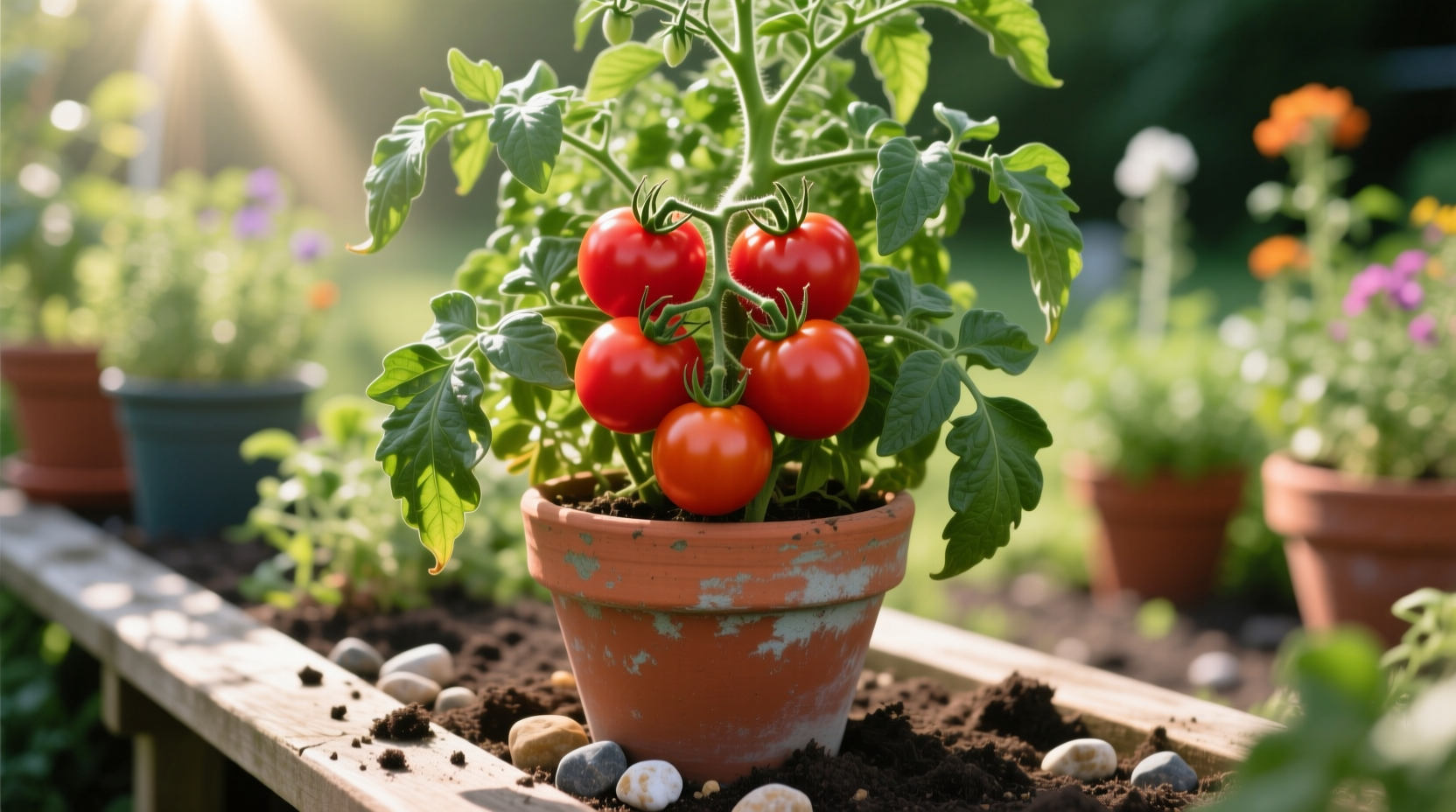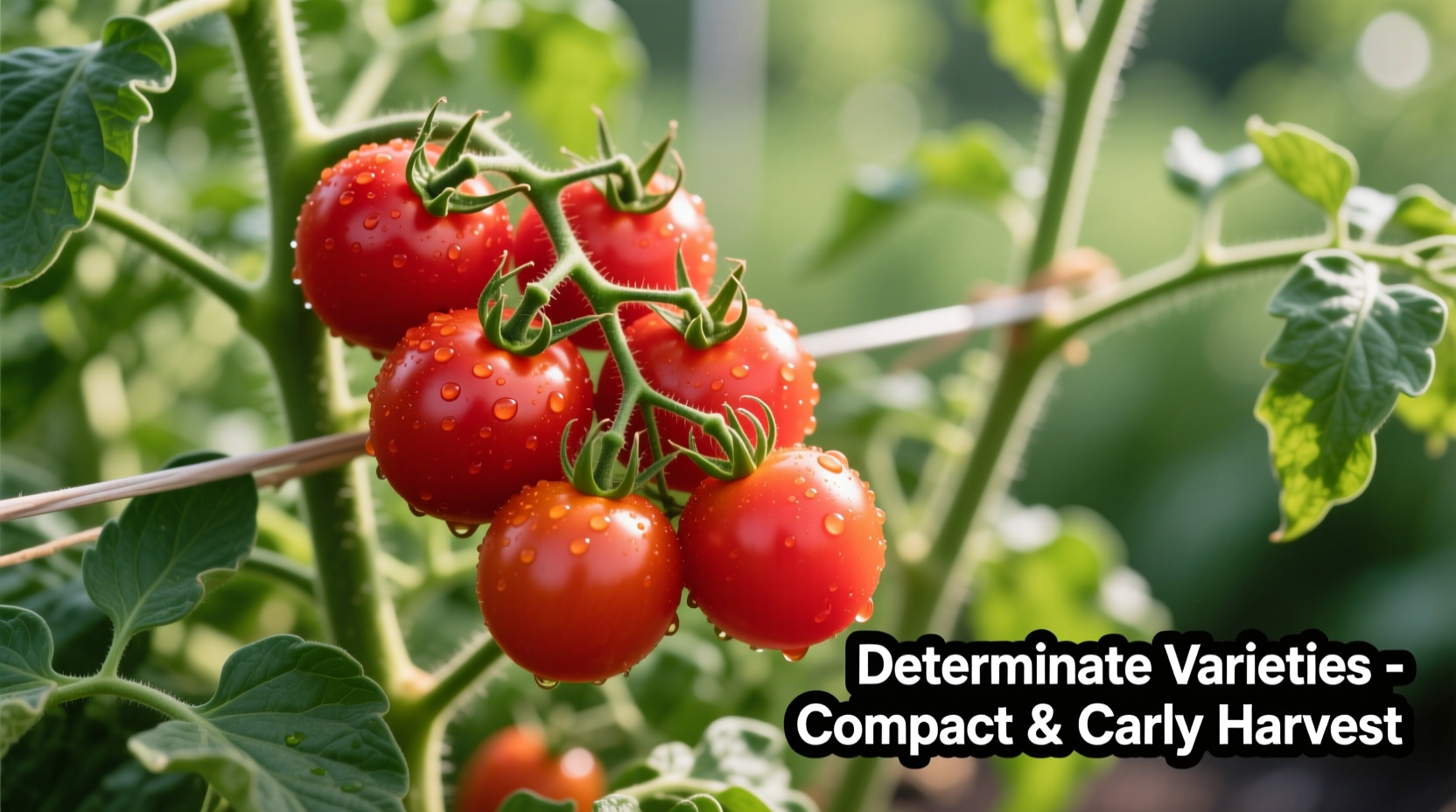Why Determinate Tomatoes Belong in Your Garden
Whether you're working with a balcony container garden or planning your backyard plot, understanding determinate tomato varieties can transform your harvest success. These compact plants solve common gardening challenges like limited space, unpredictable weather windows, and the need for efficient harvesting. Unlike their sprawling cousins, determinate tomatoes deliver predictable results with less maintenance—perfect for busy gardeners and urban growers.
Determinate vs. Indeterminate: The Critical Differences
Before selecting varieties, understand how determinate tomatoes differ fundamentally from indeterminate types. This knowledge prevents planting mistakes that lead to disappointing harvests.
| Characteristic | Determinate Tomatoes | Indeterminate Tomatoes |
|---|---|---|
| Growth Habit | Compact bush (3-4 feet max) | Vining (6+ feet, continuous growth) |
| Harvest Period | Concentrated (2-3 weeks) | Continuous throughout season |
| Pruning Needs | Minimal (only remove diseased leaves) | Regular pruning required |
| Support Requirements | Small cages or single stakes | Heavy-duty trellising needed |
| Best For | Canning, containers, small spaces | Fresh eating throughout season |
Top Determinate Varieties for Specific Gardening Goals
Not all determinate tomatoes serve the same purpose. Match varieties to your gardening objectives for optimal results.
Best for Container Gardening
When space is limited, these compact determinate varieties thrive in pots:
- Patio Princess (18-24 inches tall) - Produces full-sized tomatoes in 5-gallon containers
- Bush Early Girl - Delivers early harvests in small spaces with disease resistance
- Tumbling Tom - Perfect for hanging baskets with trailing growth habit
According to Cornell University's gardening resources, container-grown determinate varieties require at least 5 gallons of soil volume and consistent moisture monitoring since pots dry out faster than garden beds (Cornell Cooperative Extension).
Top Choices for Canning and Preserving
For gardeners processing tomatoes, these determinate varieties offer the concentrated harvest needed:
- Roma - The classic paste tomato with thick flesh and low moisture content
- San Marzano - Longer, thinner fruit ideal for sauces with rich flavor
- Amish Paste - Heirloom variety with exceptional canning qualities
The USDA Agricultural Research Service notes that determinate paste varieties like Roma typically have higher soluble solids content (4-6%) compared to slicing tomatoes (3-4%), making them more efficient for sauce production (USDA ARS).
Early-Season Determinate Varieties
For short growing seasons or beating the heat, these determinate varieties deliver:
- Fourth of July - Matures in just 49 days with classic tomato flavor
- Quick Pick - Ready for harvest in 52 days with crack resistance
- Bush Beefsteak - Large fruits maturing in 62 days on compact plants

When Determinate Tomatoes Shine: Practical Applications
Determinate varieties excel in specific scenarios where their growth habit provides distinct advantages:
Small Space Gardening Solutions
Urban gardeners and those with limited yard space benefit significantly from determinate tomatoes' compact growth. These varieties work well in:
- Container gardens on patios and balconies
- Narrow garden beds between other crops
- Community garden plots with size restrictions
Concentrated Harvest Requirements
Choose determinate varieties when you need:
- Simultaneous ripening for canning batches
- Single harvest before vacation or seasonal changes
- Uniform fruit maturity for market sales
Low-Maintenance Gardening
Determinate tomatoes require less ongoing care than indeterminate types:
- No regular pruning needed (beyond removing diseased leaves)
- Simpler support systems (small cages instead of elaborate trellises)
- Shorter growing season reduces pest exposure
Evolution of Determinate Tomato Varieties
Determinate tomatoes weren't always common in home gardens. Understanding their development helps explain their current characteristics:
- 1940s: First commercial determinate varieties developed for mechanical harvesting in California
- 1960s: Introduction of 'Roma' revolutionized paste tomato production
- 1980s: Disease-resistant determinate varieties became widely available
- 2000s: Compact determinate varieties bred specifically for container gardening
- Present: Heirloom determinate varieties gaining popularity among home gardeners
Research from the University of California shows that modern determinate varieties have significantly improved disease resistance compared to early versions, with many now featuring resistance to fusarium wilt, verticillium wilt, and nematodes (UC Master Gardeners).
Planting and Care Guide for Determinate Tomatoes
Follow these specific practices for successful determinate tomato cultivation:
Planting Requirements
- Space plants 24-36 inches apart (closer than indeterminate varieties)
- Plant at same depth as nursery container (unlike indeterminates which benefit from deep planting)
- Use smaller supports (18-24 inch cages work best)
Nutrition and Watering
- Apply balanced fertilizer at planting (10-10-10)
- Switch to low-nitrogen, high-phosphorus fertilizer when flowers appear
- Water consistently (1-2 inches per week) to prevent blossom end rot
Harvest Timing
Monitor fruit color closely as determinate varieties ripen simultaneously. Harvest when tomatoes show full color development but remain firm. Unlike indeterminates, determinate plants won't continue producing after the main flush, so timing your harvest is crucial.
When to Choose Determinate Varieties: Decision Guide
Select determinate tomatoes when:
- You have limited garden space or container gardening
- You need a concentrated harvest for canning or preserving
- Your growing season is short (under 100 days)
- You want lower-maintenance plants with minimal pruning
- You're growing in areas with late-season disease pressure
Choose indeterminate varieties instead if:
- You want continuous fresh tomatoes throughout the season
- You have ample space for sprawling plants
- You're willing to invest time in regular pruning and trellising
- You're growing in a climate with long growing seasons
Common Questions About Determinate Tomato Varieties
Can determinate tomatoes be pruned to increase yield?
Unlike indeterminate varieties, determinate tomatoes should not be heavily pruned. Their growth pattern is genetically programmed to stop at a certain height, and excessive pruning can actually reduce your total yield. Only remove diseased or damaged leaves to maintain plant health without interfering with the natural fruiting pattern.
How long do determinate tomato plants produce fruit?
Determinate tomato varieties typically produce one main harvest over a 2-3 week period. After this concentrated fruiting phase, production significantly decreases as the plant reaches the end of its natural growth cycle. This makes them ideal for gardeners who want a large quantity of tomatoes at once for canning or preserving.
Do determinate tomatoes need cages or supports?
Yes, most determinate varieties benefit from small cages or single-stake support. While they don't grow as tall as indeterminate types, the weight of ripening fruit can cause branches to break. Use 18-24 inch cages that fit the plant's compact size, installed at planting time to avoid root damage later.
Can I grow determinate tomatoes in containers?
Determinate tomatoes are excellent for container gardening. Choose compact varieties like 'Patio Princess' or 'Bush Early Girl' and use containers with at least 5 gallons capacity. Ensure proper drainage and use quality potting mix, as garden soil compacts in containers. Container-grown determinate tomatoes require more frequent watering but offer the advantage of mobility if weather conditions change.
Why are my determinate tomatoes not producing fruit?
Several factors can prevent fruit set in determinate tomatoes: extreme temperatures (above 90°F or below 55°F), inconsistent watering, insufficient sunlight (less than 6-8 hours daily), or over-fertilization with nitrogen. Unlike indeterminate varieties, determinate plants have a limited fruiting window, so timing your planting to avoid temperature extremes is crucial for successful harvests.











 浙公网安备
33010002000092号
浙公网安备
33010002000092号 浙B2-20120091-4
浙B2-20120091-4